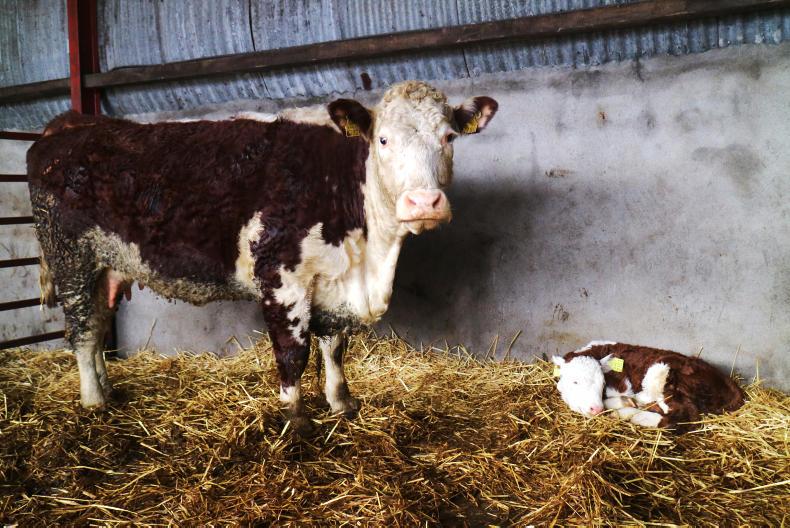
Results from the National Farm Survey (NFS) paint a sobering picture for Irish beef producers – the average enterprise is loss-making before subsidies are taken into account. But who wants to be average, right?
Successful beef farmers get more beef out the gate per unit of land than the average producer.
In the two preceding phases of BETTER farm, output and profitability were intrinsically linked. By pushing stock numbers and grassland, our BETTER farmers drastically improved their farms’ bottom lines. Indeed, stocking rates at the end of phases 1 and 2 were 2.24 and 2.27LU/ha respectively. According to the NFS, average stocking rate on beef farms across the country is between 1.2 and 1.3LU/ha. The potential is there, but any increase in stocking rate must be done in an uber-efficient manner to be worthwhile.
Push
A significant increase in stocking rate will be on the agenda for most of our new BETTER farms – we are aiming to get the most from every hectare. But what happens when there are 123ha to fill? What happens when labour, and not land, becomes the main factor limiting how hard the farm can be pushed?
The Stanleys in Tipperary farm a massive 123ha (304 acre) holding near Thurles. The land is laid out in one block and supports 110 suckler cows and a dairy beef enterprise. There are three men farming full-time here – brothers Raymond and Gilbert, as well as Raymond’s son Dwayne.
We pay a visit to the Stanley farm, which is the biggest farm in the BETTER Farm challenge
— FJ Beef (@FJBeef) March 9, 2017
Visit https://t.co/CYzlT4K57B for more updates pic.twitter.com/LjDGsJFSkd
BETTER farm phase three is going a step further than previous phases in that this time around we are evaluating both the profitability of a system and the viability of the farm business, as opposed to just the former. The Stanley farm needs to provide a full-time income to three men. In 2016, the three men earned less than €5/hour each (total net profit, excluding subsidies, divided by hours worked).
Suckler numbers
“There are 110 suckler cows calving here at the moment, with a 65/45 split between spring and autumn,” Dwayne told me. “Of course we could take on more cows, but I think that 120 will be our maximum. I’m aiming to get our spring and autumn calving spreads to sub three and two months respectively. While labour would be tight if we took on more cows, we just don’t have the facilities to accommodate big numbers of cows and calves. I think our dairy-calf-to-beef enterprise is where we can make big output gains. Also, there’s potential for some summer finishing down the line,” Dwayne said.
The Stanleys are actively buying in beef-cross dairy calves. To date, there are 60 animals on the farm and the plan is to rear 80 in 2017, pushing to 100 in the coming years.
“I look for a strong beef-cross calf. We’ve got Hereford, Charolais and Limousin calves in so far. I also want males preferably – we’re around 75% male at the moment. In terms of price, I’m giving €300 for Herefords, €350 for Charolais and €330 for Limousins. All are coming directly from farms. The males will complement our own suckler animals, finishing as steers at 24 months, with target carcase weights of 350kg. I’m also on the lookout for some Simmental/British Friesian-cross heifers at present. I’d like to incorporate some of these genetics into the suckler herd.”
Quick finish
The Stanleys’ other option for boosting output is to go down the store bull route during the summer. This would involve purchasing suckler-bred bulls as yearlings (~500kg) for a quick finish indoors, once their own stock have gone to grass. There are good housing facilities on the farm, with one shed in particular away from the main yard ideal for housing and feeding bulls (pictured). Previous BETTER farmers such as the Beirnes in Longford and Mike Dillane in Kerry had great success in complementing their own suckler stock with bought-in, quick finish cattle.
“Yea it’s something we’ll definitely consider,” Dwayne said. “Look, cashflow could be better here and a bull system needs a much bigger initial outlay than our calf-to-beef operation, but the beauty of it is the quick turnaround. We could have bulls in and out in 100 days. I’d like to optimise my calf-to-beef system first, but to hit our targets we’ll need more beef output, even at 120 cows and 100 calves. Bull finishing represents a way of achieving this without putting a huge stress on labour.”
Table 1 outlines the targets that the BETTER team, along with local B&T adviser Michael Daly, have put in place for the Stanleys. They are producing €955 worth of beef per hectare, and the target is for this to double.
The predicted variable costs for when the farm reaches this production level are outlined below. At a variable cost level of €1,049/ha, the Stanleys’ gross margin should increase above €1,000/ha – a phenomenal achievement on a holding this size. There should be minimal effects on fixed costs as a result and this will significantly improve their return per hour worked. The bull system will also help improve the farm cashflow.

Fertiliser (incl service of soil P & K levels): €30,000
Contractor (some machinery already on farm): €7,000
Vet: €10,000
Feed bill: €70,000
Straw: €3,000
Seeds/spray: €4,000
Sundry and levies: €5,000
Total: €129,000 (€1,049/ha)
The Stanleys have a big output challenge ahead. Farming has been done in the more traditional sense on this farm in the past and grassland needs attention in terms of paddocks, water troughs, fertility and reseeding. This will form the cornerstone of producing extra beef cheaply. Liveweight gain will need to improve also. Extra dairy-bred calves will increase output cheaply. The main challenge will be finance. Given the scale of the farm, many of the typical improvement costs are magnified. However, the investment is necessary to hit the targets set out.
